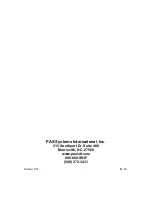
12
The PAS V readings should not be taken as an accurate indication of the
strength of the drink. However, with a little experience you should be able to
distinguish between beer, wine, and spirits. Take the time to practice on various
drinks and develop an operating style that avoids overloading the instrument.
CAUTION!
Be aware that certain citrus-based beverages, flavored waters, and
some Starbucks coffees have been
reported to give a positive reaction
when
sampled with a Passive Alcohol Sensor.
For Example: Citrus-Based beverages such as Mountain Dew, Mello Yello,
Code Red, etc., may give positive readings. It’s not clear if these beverages are
in fact fermenting and producing low levels of alcohol, or if certain ingredients are
reacting chemically with the fuel cell in some way to provide a positive reading.
To minimize confusion, always retest subjects (individuals) about 15
minutes after an initial positive reading to verify true alcohol presence and
not the result of residual mouth alcohol from these types of beverages.
However, individuals may “spike” these drinks to cover up their actual
alcohol consumption. Wait 15 minutes and retest the subject (following
sampling instructions on page 7) to verify if they are abusing alcohol.
Fur
ther, always conduct an “air blank” between samplings to ensure the fuel cell
sensor is clear of any residual alcohol carried over from the prior sample. “Air
Blanks” are done by simply activating the pump and processing a sample of
alcohol-free ambient air. Observe the display for approximately five to ten
seconds after the sample pump has stopped. If no bars light up you may
assume the sensor is free of any carry-over and you may proceed with sampling
the next subject (individual).
Secondary Investigative Light (On back of device)
To use the Secondary Investigative Light, turn on the PAS V main Flashlight
switch. This will also turn on the Seconday Investigative light on the back of the
flashlight body.
Option1: Green Horizontal Gaze Nystagmus Test (HGN) Light
The HGN test is one of three field sobriety tests developed by the National
Highway Traffic Safety Administration (NHTSA). For more information on
administering the HGN Test can be found at nhtsa.dot.gov
Option 2: Blue Ultraviolet (UV) Light
Hold the UV light several inches above any item or surface to illuminate any UV-
sensitive object or residue.
*CAUTION
– Do NOT shine the Ultraviolet (UV) light directly into eyes.










































